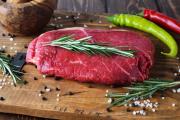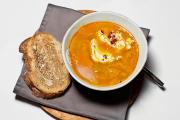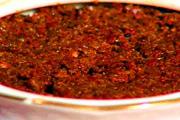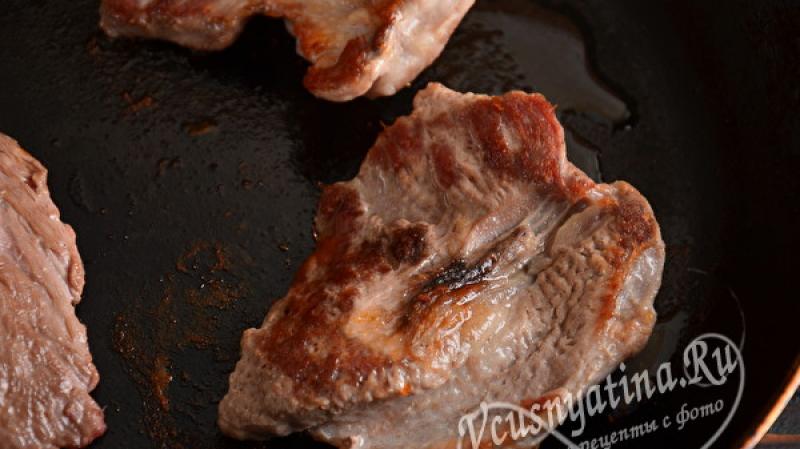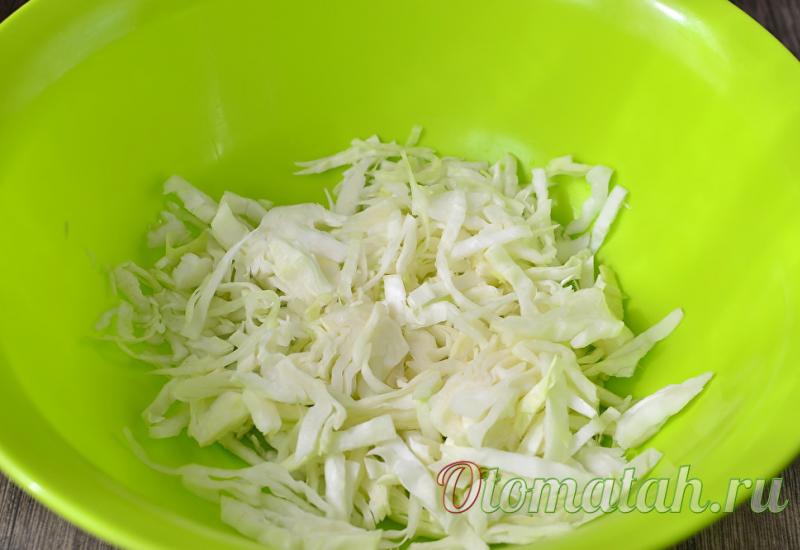Homemade milk sauce recipe. Dairy and sour cream sauces. Milk sauce with cheese
Dairy and sour cream sauces prepared on a white fat or dry sauté, as well as on potato starch. Milk and sour cream are pre-boiled.
milk sauce . White fat passerovka is diluted with hot milk with continuous stirring and heating, boiled for 5-7 minutes, salt is added (sugar can be 10 g per 1 liter), filtered, brought to a boil, seasoned with butter. This sauce is served with vegetable, meat and fish dishes.
Milk 1000, butter 60, wheat flour 50.
Milk sauce (for baking) is prepared in the same way, but raw egg yolks (2 pieces per 1 liter) can be added to the finished sauce. Use it for baking or seasoning dishes from meat, fish, vegetables.
Milk “1000”, butter 90, wheat flour 90.
On the basis of milk sauce, derivative sauces are prepared.
Sweet milk sauce . Sugar (80-100 g) and vanillin (0.05 g) are added to the milky liquid sauce. Served with cheesecakes, puddings, casseroles.
Milk sauce with sour cream . Boiled sour cream, salt are introduced into the milk sauce and boiled for 3-5 minutes. Use for cooking beef stroganoff and other meat and fish dishes.
Milk sauce 750, sour cream 250.
Milk sauce on potato starch. Potato starch is diluted with cold boiled milk (0.1 of the entire norm of liquid), poured, stirring, into boiling milk, brought to a boil and immediately stopped heating.
Starch should be introduced quickly, all at once, since lumps form if it is incorrectly introduced. The sauce is seasoned with salt, filtered, added butter. You can put sugar.
Milk 1000, potato starch 30 g
sour cream sauce . This sauce is prepared on sour cream, as well as on broths and vegetable broth with the addition of sour cream.
White dry browning is cooled, mixed with softened butter until smooth, diluted with a small amount of liquid and combined with boiling broth. The mixture is boiled, stirring, for 5-10 minutes, then filtered. Hot sour cream, salt are added to the resulting white sauce and boiled for B-10 minutes. Served with various dishes of vegetables, fish and meat (meatballs, liver, cabbage rolls).
Based on sour cream, derivative sauces are prepared.
Sour cream 250, butter 75, wheat flour 75, broth or broth 750.
Sour cream sauce with tomato (pink). Tomato puree is sauteed in butter and combined with hot sour cream sauce, stirred, salt is added, boiled for 5-7 minutes, seasoned with butter. Served with dishes from stuffed vegetables, meatballs and other dishes.
Sour cream sauce with egg . Eggs are boiled hard-boiled, cooled, finely chopped together with parsley or dill, combined with boiled sour cream, cooled to 50-60 ° C, salt is added, Served with potato, carrot and rice cutlets, boiled and stewed fish.
Those who were lucky enough to enjoy dishes with this gravy in their childhood know how harmoniously it goes with everything. It was served with everything: meatballs, cutlets, pasta and was often used for baking. We can confidently say that this is one of the most versatile sauces that housewives often use. This classic milk gravy recipe is just the thing to take your dish to the next level of flavor.

Ingredients
- Fat milk - 500 ml
- White flour - 2 tbsp. l.
- Butter - 60 g
- Salt - to taste
How to cook milk gravy: a step by step recipe
Before proceeding to cooking, it is worth noting that the ingredients are designed for average density. To get a liquid gravy, it is enough to reduce the amount of flour and butter by half.
- Dry the white flour. This is some kind of "secret" to successful milk gravy, which, alas, many people neglect. Pour two large spoons of flour on heated frying pan and dry it. In no case do not bring to a color change, you just need a light roast. Then cool it down.
Calcined flour will save you from hated lumps and easily mix with any liquid. It will also remove the gelatinous flavor from your gravy. - Once you're done with the flour, pour it into a saucepan or saucepan. Add salt and 1/4 of our milk to it.
- Stir until all lumps formed are gone. Try to break them up as they appear, the quality of the gravy depends on these actions.
- As soon as lumps stop forming, pour in the remaining milk. Cooking 6 minutes on low fire.
- Then add butter, mix well and boil.
Clarification "just in case"
To cool means to pour the flour into another container, and not leave it in a hot pan. This is a mistake that beginners often make.
Clarification "just in case"
The concept of “boil”, surprisingly, seems to many to be superficial. Therefore, I will clarify that you should bring the gravy to a boil and immediately turn it off, and not wait until it boils away.
Secrets of milk gravy and what to serve it for
Depending on what dish it is intended for, in your plans, the recipe can be improved. For dessert, it is enough to replace salt with sugar. If serving is planned with fish or meat, you can add pepper and chopped greens to the composition. To give the dish a subtle flavor, try adding chopped nutmeg, which is often very useful.

Remember that everyone has their own tastes and it is better to serve gravy to guests separately from the dish.
The classic milk sauce is nothing more than the world-famous bechamel sauce. Every cook knows how to cook it. And having learned how to quickly and correctly cook such a sauce, you can, using various additives to taste, vary the shade of aroma and taste, and the consistency of the sauce.
Bechamel is very easy to make. However, to achieve the perfect result, you need to know a few secrets. I will gladly share all the secrets with you!

And to show how easy it is to change the basic recipe, we will prepare not classic bechamel but with the addition of cheese. And we get a delicious milk sauce for fish.
- Total cooking time - 0 hours 10 minutes
- Active cooking time - 0 hours 10 minutes
- Cost - very economical
- Calorie content per 100 gr - 214 kcal
- Servings - 5 servings
How to make milk sauce for fish
Ingredients:
- Milk - 1 tbsp. (200 ml)
- Wheat flour - 2 tbsp.
- Butter - 2 tbsp.
- Hard cheese - 70 g
- Salt - to taste
Cooking:
So, for the classic bechamel recipe, we need products that every housewife usually has in the refrigerator: milk, butter and flour. Everything! This is enough to make the base for the sauce.
Often in recipes there are such equivalent replacements: butter - for margarine, flour - for starch.
I used to be calm about margarine, but over time, firstly, I realized that such fat often contains vegetable components, and secondly, no matter how margarine makes the dish cheaper, you will still feel a difference in taste. It tastes better with butter, but I won’t insist too much.
As for starch, it can serve as a sauce thickener, but the technology for introducing it into the sauce is somewhat different (I will talk about this in more detail at the appropriate stage).
Before preparing the sauce, be sure to collect all the ingredients so that they are at your fingertips. Because the sauce cooks very quickly and will require your constant attention. Therefore, let's start by measuring the right amount of flour and butter and rub hard cheese.
For 1 glass of milk, take 2 tablespoons of flour and 2 tablespoons of butter if you plan to make a thick milk sauce. So thick that it sticks to a piece of fish, sliding heavily onto a plate. If you need a rarer sauce, then take 1.5 tablespoons of flour and butter. If desired, make a rare sauce - 1 tablespoon. A rare sauce is often prepared in order to stew or bake a dish in it.
You can use any cheese for the sauce. Which one you take - you will get such an accent of taste. I used regular hard cheese ("Russian") because I wanted to enhance the creamy, milky notes of the sauce.

First of all, we send butter to a hot frying pan and melt it. Watch carefully - the oil should not boil. Enough to melt it.

Now gradually add the flour to the butter. Add little by little, stirring all the time. No need to overcook the flour. Let it be slightly golden in color, the whole oily-flour mixture should be the color of ripe wheat. As a result, we got the so-called white roux (the term for French cuisine).
It could have been done differently. In a dry hot frying pan, calcine the flour, stirring thoroughly, then add the already melted butter into it. The end result should be the same in both cases.
If you use starch instead of flour as a thickener, then it does not need to be calcined or fried. Starch is immediately combined with milk, mixed and added to melted butter.

Add milk to the butter-flour mixture. I read different opinions about what temperature milk should be. For myself, I chose the easiest way - I add milk at room temperature to the pan. It’s easier for me and I didn’t notice any special pitfalls in using cold milk.
After adding milk, stir the sauce all the time and cook for about 4-5 minutes. At first it will seem to you that the sauce is very liquid, but it will take just a couple of minutes and the sauce will begin to thicken rapidly. At this stage, you need to add flavor accents: salt, pepper, nutmeg, sugar and vanillin (for sweet dishes), etc. I limited myself to salt and grated cheese.
Very important nuance. There is no need to add acidic ingredients to the milk sauce. For example, such as: lemon juice, wine, vinegar and so on. The fact is that when adding acid, the sauce will almost certainly curdle. And then you have to redo everything. In the case of fish, it is better to pour the finished portioned piece with lemon juice, and only then put a spoonful of ready-made bechamel milk sauce with cheese on top.
Also, when considering the density of the future sauce, do not forget that you will add cheese. Cheese will add thickness and volume, which means you need to reduce the amount of flour and butter in advance (although my family likes milk sauce to be thick, so I put a small piece of cheese to the same 2 tablespoons of flour and butter). In addition, the cheese itself has a salty taste (especially blue cheeses), so be careful with salt.

ready sauce it is often recommended to strain. I do not have such a need - the sauce comes out uniform and beautiful. Therefore, I immediately serve it hot with pink salmon baked in a sleeve with spices and rose wine. I like to add an unusual taste and aroma to my dishes, so I flavored the sauce with a sprig of fresh catnip (a type of mint with lemon essential oils).

It's no secret that with a well-chosen and well-prepared sauce, almost all dishes become tastier. However, not all modern housewives agree to spend a lot of time and effort on preparing gravy. They want to find a recipe to make delicious sauce from available products in a relatively short period of time. Such recipes exist. It is absolutely easy to prepare a completely versatile and not too high-calorie sauce made from milk, butter and flour. It refers to classical kitchen and is considered the main sauce, that is, it can not only serve as gravy, but can also be used to prepare other sauces and dishes. This sauce is versatile: it can be used for baking or as a gravy for meat, fish, pasta, vegetables, and if you cook it thick, it will become an excellent filling for donuts.
Cooking features
As already mentioned, the process of preparing milk sauce is not very difficult and does not take much time, but the hostess cannot do without knowing some of the subtleties.
- The amount of flour used in the recipe depends on how thick the sauce you want to make is. To make a thick sauce for a glass of milk, you need to take a third of a glass of flour, that is, about 50–60 g. as a gravy, a liquid sauce is most often made, for which a tablespoon of flour with a slide (about 20 g) is taken for two glasses of milk. The amount of butter usually matches the amount of flour used, that is, for a thin sauce you need 20 g of butter, for a medium-thick sauce - 40 g, for a thick one - 60 g of butter.
- In order to prevent the formation of lumps in the preparation of the sauce, the flour is initially calcined in a dry frying pan. This should not be done for long: as soon as a nutty aroma appears, the pan with flour is removed from the heat. The cooled flour is transferred to a saucepan and proceed to the next stage of preparing the sauce.
- Milk is introduced into the sauce in small parts, each time whisking the contents of the saucepan with a whisk until a homogeneous mass without lumps is formed.
- The next step is to add the butter cut into pieces. As soon as the oil has dissolved in the sauce, it can be considered ready. However, even after that, additional ingredients can be introduced into it: herbs, seasonings, salt or sugar. In this case, you can cook the sauce a little longer.
- Some recipes suggest thickening the sauce not with flour, but with eggs or starch. In this case, the technology will be slightly different. If egg yolks are used, then the sauce is heated in a water bath or very low heat, while trying not to bring it to a boil. If starch is indicated in the recipe, then it is poured into hot sauce, having previously been dissolved in cool water.
- It is best not to use ingredients such as vinegar or lemon juice when making milk sauce, as the milk may curdle.
Milk sauce is most often used hot, pouring it over dishes before serving. Most often used for meat classic version sauce, for fish - sauce with garlic, for pasta - with cheese, and for desserts - sweet milk sauce.
Classic milk sauce recipe
- wheat flour - 20–120 g;
- butter - 20–120 g;
- milk - 0.5 l;
- nutmeg (optional) - on the tip of a knife;
- salt or sugar - to taste;
- greens (optional) - to taste.
Cooking method:
- Sift the flour and pour into the pan. The amount of flour is determined based on how thick the sauce you want to cook. Most often, a medium-thick sauce is made, which requires about 40 g of flour.
- Put the flour pan on the fire. Ignite the flour, stirring, until a nutty smell appears.
- Remove the pan from the heat, pour the flour into a saucepan and wait a couple of minutes until it cools down.
- Light a fire under the saucepan and start pouring milk into it in a thin stream, while whisking it with a whisk.
- Cut the butter into thin slices and dip them into a saucepan with sauce. Stir to make it dissolve faster.
- Add salt or sugar, depending on what dish you are preparing the sauce for. If you do not plan to serve it with dessert, you can additionally add pepper and finely chopped or chopped greens with a blender. Nutmeg adds a nice flavor to the sauce.
- When the sauce has thickened sufficiently and the added salt or sugar has dissolved in it, remove the saucepan from the heat.
After that, the sauce can be used immediately for its intended purpose or poured into a saucepan and put on the table so that guests can pour it over the dishes served to them on their own.
Milk sauce with ginger and garlic for fish
- flour - 20 g;
- butter - 20 g;
- milk - 0.25 l;
- parsley - 20 g;
- ginger root - 10 g;
- garlic - 1 clove;
- salt, pepper - to taste.
Cooking method:
- Peel and grate the ginger root.
- Pass the garlic through a press.
- Finely chop the parsley with a knife.
- Roast the flour for a nutty flavor. Remove from heat for a while.
- Return the skillet with flour to the stove. Introduce milk in small portions. Remember to beat it with a whisk so that there are no lumps. If, nevertheless, it was not possible to avoid their formation, strain the sauce through a sieve and return to the stove.
- Add the ginger, garlic, parsley, salt and pepper to the sauce. At the same time put a piece of butter in it.
- Continue heating the sauce until the oil has dissolved in it. All this time it needs to be stirred.
Milk sauce prepared according to the above recipe will be a good addition to fish dishes.
White sauce with onions and mushrooms
- milk - 0.25 l;
- flour - 40 g;
- butter - 40 g;
- onions - 100 g;
- champignons - 100 g;
- salt, spices - to taste.
Cooking method:
- Peel and finely chop the onion.
- Wash, dry the mushrooms with a napkin. Cut them into small cubes.
- Melt the butter in a frying pan, put the onion and mushrooms in it and cook until the liquid released from the mushrooms has evaporated.
- In a clean frying pan, heat the flour for a minute. Pour milk into it in a thin stream, constantly whisking it with a whisk.
- Add mushrooms and onions to the sauce, stir.
- Cook until the sauce thickens sufficiently.
This sauce goes especially well with meat and vegetables. It can be made only with mushrooms or only with onions. In this case, the amount of mushrooms or onions can be increased one and a half to two times relative to the amount indicated in the recipe.
Milk sauce with cheese
- milk sauce prepared according to classic recipe, - 0.3 l;
- hard cheese - 50 g;
- butter - 20 g;
- broth - 100 ml.
Cooking method:
- Boil the broth, mix it with the sauce. Heat the resulting mixture over low heat.
- Finely grate the cheese and send it to the sauce. Heat the sauce, stirring, until the cheese has melted.
- Remove the sauce from the stove, add a piece of softened butter to it, beat with a blender.
This sauce goes well with potatoes, pasta, vegetable casseroles, giving them a creamy cheese flavor.
Sweet milk sauce
- flour - 30 g;
- butter - 30 g;
- sugar - 60 g;
- vanillin - on the tip of a knife;
- cinnamon (optional) - a pinch.
Cooking method:
- Boil milk by adding sugar to it. Wait for it to dissolve. Cool to room temperature.
- Fry the flour to a caramel shade and pour milk into it in a thin stream, whisking it constantly.
- Add vanilla, cinnamon and thinly sliced butter.
- Continue heating the sauce, stirring, until it has an even, thick consistency. During this time, the butter should completely melt.
This sauce can be poured over cheesecakes, pancakes or pancakes. If you want to use it as a filling, you need to take 4 times more flour and butter when cooking.
Milk sauce is a versatile seasoning that can be served with side dishes, meat and fish dishes, and even desserts. It is prepared quickly and from available products. Even an inexperienced hostess can master the technology of making the sauce.
Milk sauce is a culinary condiment that complements meat and vegetable dishes. There are many varieties of milk sauce - sweet and spiced, thick and thin, for chicken, fish or vegetables. There are two common products in all recipes: natural milk and flour. To add flavor to the sauce, add spices, sugar, cheese, herbs, eggs, broth, sour cream or vanillin. Let's take a few of the most delicious recipes milk sauce.
Thick milk sauces
Thick milk sauce is added to ready meals(for example, to boiled potatoes) or is used as a binder when kneading minced meat for vegetable cutlets. In all milk sauces, flour is a thickener, by adjusting its amount in the recipe, you can get a very thick seasoning or the thinnest sauce in the world. For a thick seasoning, the ratio of flour and milk should be 3: 1 (there should be three times more milk than flour).
Thick milk sauce is prepared from the following products:
- Milk 350 g;
- Flour 120 g;
- Natural oil 120 g;
- Salt (approximately 8-10 g).
You can measure the volume of products with a teaspoon (it contains 5 g of salt or sugar), a tablespoon (it holds 30 g of flour), a glass (200 g of liquid is placed in it) or kitchen scales (it is convenient to measure the mass of flour with them).

Add to vegetable or meat side dishes as a tasty and nutritious seasoning.

Milk sauce and spices
A traditional thick sauce recipe can be enriched with flavor by adding spices to it. What spices go well with the taste of milk sauce?

You can add any favorite spices to the milk sauce. This seasoning is a great addition. meat dish or fish. In addition, spices are antioxidants, they help the protein dish to be fully digested and assimilated.
Milk sauce with onions or mushrooms
An interesting version of the milk sauce is prepared with fried vegetables. Refueling with onions prepared on the basis of fried onions. For cooking, the following products are needed:
- Milk 200 g;
- Flour 60 g;
- Butter 50 g (two tablespoons);
- Onions - 2 or 3 heads;
- Spices and salt.
The sequence of steps for preparing milk sauce with onions is as follows:
Milk sauce with mushrooms is prepared according to a similar recipe. Instead of onion use 100 g fresh mushrooms. They are also finely chopped and fried.

Nutritious milk sauce with cheese
The taste of milk sauce can be enriched with egg or cheese. It will turn out a tasty and nutritious seasoning, which can be used not only as an addition to cereals, pasta, salads.
Cheese sauce is successfully used in vegetable salads. For its preparation, ready-made milk sauce is used. Other Ingredients:
- Milk sauce - 650 g;
- Hard cheese - 100 g;
- Broth - 250 ml;
- Butter - 50 g.
To prepare seasoning proceed as follows:
- Heat the broth without boiling (40 - 45 ºC).
- Mix hot broth with ready sauce.
- The cheese is rubbed on a fine grater and added to the hot mixture, mixed thoroughly.
- After cooling, add soft butter and beat with a blender.
Sweet milk sauce
A sweet sauce made from milk and sugar is a favorite treat for those with a sweet tooth. It is prepared with the addition of sugar and vanillin.
Ingredients:
- Milk - 1 liter;
- white flour premium- 60 g;
- Oil - 60 g;
- Sugar or granulated sugar - 120 g (for the pleasure of the sweet tooth);
- Vanillin (for aromatic smell).
The sequence of actions is as follows:
- Sugar is dissolved in a small amount of hot milk (a little milk liquid is poured from the prepared 1 liter);
- Flour is fried;
- Milk is heated and added to the fried flour, stirring constantly;
- Combine sugar milk syrup and milk solution of flour, mix, cool and beat with a blender.
Milk sauce is served with sweet dishes: casseroles, pancakes, sweet curd mass, added to fruit salads and baby cereals.
Ready salad dressing is placed in a beautiful dish and served at the common table. For aesthetic pleasure, it is important to place the milk sauce in a beautiful bowl or sauce vase.

A variety of recipes for sauces allows you to eat a new dish every day with a new milk sauce.
